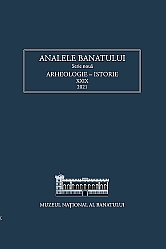Demografie și economie în Granița Militară Bănățeană la începutul secolului al XIX-lea
Demography and Economy in the Banatic Military Border at the Beginning of the 19th Century
Author(s): Costin FeneşanSubject(s): Local History / Microhistory, Military history, Modern Age, Demography and human biology, 19th Century
Published by: Editura Mega Print SRL
Keywords: Military Community Bela Crkva; Military Community Pancevo; Romanian-Illyric Regiment no. 13; German Banatic Regiment no. 12; Banatic Military Border;
Summary/Abstract: On May 13th, 1807 lieutenant-general baron Friedrich Peter von Duka, the military commander in chief of the Banat, sent to the Court Council of War (Hofkriegsrat) an exhaustive demographic and economic statistic of the Banatic Military Border (the German-Banatic Regiment No. 12 with the military community in Panciova/Pančevo and the Romanian-Illyirc Regiment No. 13 with the military community in Biserica Albă/Bela Crkva). This very interesting document, preserved in Vienna at the Haus-, Hof- und Staatsarchiv, in the archival fund Hofreisen, was meant to be used in drawing up the so-called Constitution of the Austrian Military Border as of August 7th,1807. At the same time, it served as documentation to archduke Ludwig Joseph, appointed on November 1st, 1807 as inspector general of the Austrian Military Border (till 1809) and entrusted with the implementation of the new capital law for the border regiments in Croatia, Slavonia, Srem and the Banat. The statistic of May 13th, 1807 is very elaborated, including the whole Banatic Military Border and displaying information on the human resources as well as on the economic and fiscal revenues. In regard to the demographic data, general Duka’s statistic pointed out, that in the 160 villages, two military communities and one burgh of the Banatic Military Border lived at this time 157.164 inhabitants (81.028 males and 76.136 females). The population was almost equally distributed in the two regiments and military communities. As for the social structure of the population, the overwhelming majority consisted in peasant-border soldiers. It is very significant, that in general Duka’s statistic are pointed out, on one hand, the male children up to the age of 14 and the teenagers from 15 to 17 years as potentially becoming border-soldiers, on the other hand the married/unmarried males and widowers, as well as the peasant-soldiers ready to be enlisted. A special column is dedicated to depict the agricultural resources: fields, pastures, meadows, orchards and vegetable gardens, moors and sandy grounds. In connection to these, the statistic from 1807 shows the number of domestic animals: horses (divided in six different types), oxen, cows and sheep. By a thorough analysis of all such information, connected to prior or newer statistics (e. g. from 1803 and 1808), as well as throughout the whole presentation, it needs to be pointed out that the economy in the Banatic Military Border was mainly one of subsistence, offering very few opportunities to any export of products. At the same time, at the beginning of the 19th century, the German-Banatic Regiment No. 12 surpassed in many regards the Romanian-Illyric Regiment No. 13. Evidence to such fact is illustrated by general Duka’s statistic, ascertaining that the revenues in the German-Banatic Regiment were far higher to those in the Romanian-Illiric.
Journal: Analele Banatului S.N. Arheologie-Istorie
- Issue Year: XXIX/2021
- Issue No: 1
- Page Range: 213-223
- Page Count: 11
- Language: Romanian

